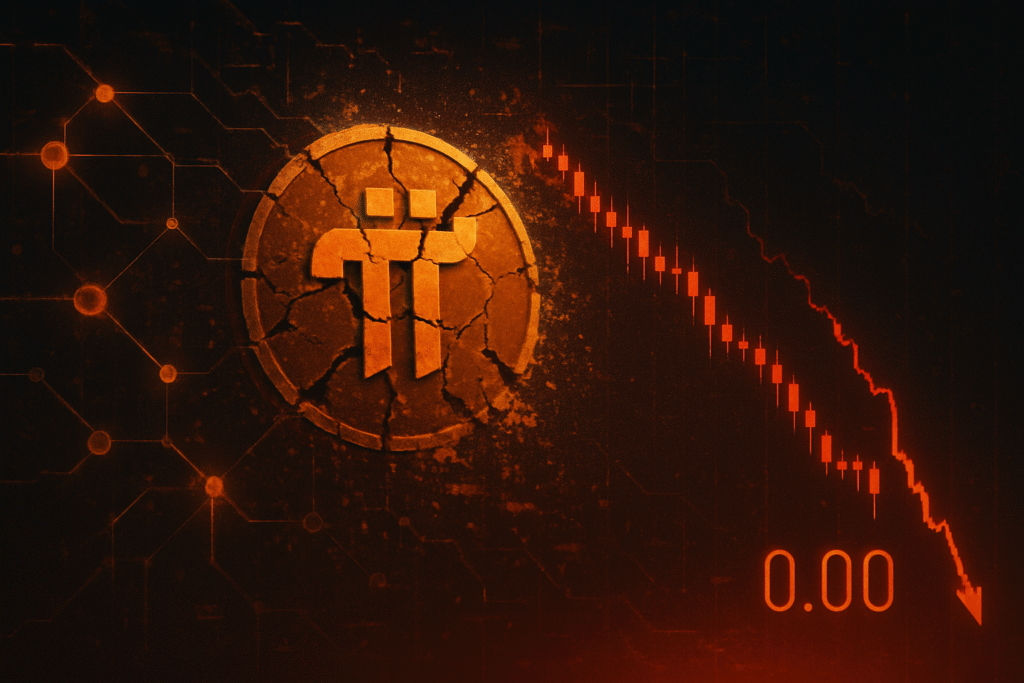
The cryptocurrency world is abuzz with a dire prediction concerning Pi Coin, the digital currency associated with the Pi Network. A growing chorus of crypto analysts and market observers foresee a potential collapse of Pi Coin's value to $0 by 2026. This stark bearish outlook, emerging in late 2025, stems from a confluence of critical issues including a problematic mainnet launch, a perceived lack of real-world utility, escalating regulatory hurdles, and an inflationary tokenomics model that continues to flood the market with supply. The implications of such a collapse extend beyond Pi Network's user base, potentially casting a shadow on other nascent blockchain projects struggling with similar foundational challenges.
The prediction, while still a year away from its projected outcome, highlights significant structural weaknesses that have plagued the project since its highly anticipated transition to an open, tradeable mainnet in early 2025. The initial euphoria surrounding the mainnet launch quickly dissipated, giving way to a sustained period of decline and disillusionment among its vast, yet increasingly frustrated, community. This scenario underscores the importance of tangible utility, robust infrastructure, and transparent governance in the fiercely competitive and rapidly evolving crypto ecosystem.
Market Impact and Price Action
The journey of Pi Coin since its mainnet launch in February 2025 has been a cautionary tale of volatility and decline. Following its listing on select exchanges like Bitget, OKX, Gate.io, and MEXC, Pi Coin experienced a fleeting surge, briefly touching nearly $3. However, this peak was short-lived, with the price plummeting to approximately $0.65 by April 2025 and hovering around $0.50-$0.60 by mid-2025. As of October 2025, its value has further eroded to a range of $0.26-$0.35, representing a staggering 90% decrease from its all-time high. This dramatic downturn is a primary driver behind the $0 prediction for 2026.
Trading volumes and liquidity for Pi Coin remain alarmingly thin, largely due to its limited listings on major, tier-one exchanges such as Binance. The rigorous assessment processes of these platforms have kept Pi Coin at bay, contributing to an unstable market where even relatively small trades can trigger significant price swings. Technical analysis reveals a consistent pattern of lower highs and lower lows, with key support levels repeatedly breached, indicating a strong bearish momentum. The current price range of $0.26-$0.35 now acts as a critical resistance, with little identifiable support below, making the path to $0 a distinct possibility should selling pressure continue.
A significant factor contributing to this market instability is the highly concentrated ownership of Pi Coin. Reports indicate that the top 100 Pi Coin wallets control approximately 96% of the total supply. This extreme concentration not only exacerbates liquidity issues but also raises concerns about potential market manipulation and the ability of a few large holders to dictate price movements, creating an environment ripe for further collapse. This situation draws parallels to other speculative assets that have seen rapid rises and falls due to concentrated ownership and a lack of genuine market depth.
Community and Ecosystem Response
The Pi Network boasts an enormous user base, estimated to be over 60 million individuals globally. However, the community's response to the post-mainnet developments has been largely characterized by frustration and disappointment. A major bottleneck has been the Know Your Customer (KYC) verification process, with only about 14 million users reportedly completing it and migrating their tokens in time to access or sell them. This has left a vast majority of users unable to realize the value of their mined coins, fueling widespread discontent across social media platforms like X (formerly Twitter) and Reddit.
Crypto influencers and thought leaders have largely adopted a skeptical, if not outright critical, stance on Pi Coin. Many point to the project's slow development, perceived lack of innovation, and the absence of compelling decentralized applications (dApps) as fundamental flaws. While the Pi Network claims a growing ecosystem of apps and merchant adoption in various countries, critics argue that the existing Pi Browser and Wallet offer only basic functionalities, failing to provide the robust utility needed to sustain a large-scale cryptocurrency. The narrative on broader crypto Twitter and Reddit often oscillates between fervent belief from dedicated 'Pioneers' and harsh criticism from external observers who label it as an 'hype-driven' project lacking substance.
The limited practical utility of Pi Coin has also prevented any significant integration with related DeFi protocols or NFT projects. Without a strong foundation of dApps that leverage the token for specific functions, the Pi ecosystem remains largely isolated from the broader Web3 landscape. This insular nature further contributes to the bearish outlook, as external demand drivers are virtually non-existent, leaving the token's value reliant almost solely on speculative interest and the dwindling hope of its massive user base.
What's Next for Crypto
The predictions surrounding Pi Coin serve as a critical reminder for the broader crypto market about the importance of utility, regulatory compliance, and sound tokenomics. In the short term, continued selling pressure from newly KYC'd users and ongoing token unlocks could further accelerate Pi Coin's decline. The absence of major exchange listings and a clear roadmap for significant dApp development are likely to keep institutional and even retail investor interest at bay, maintaining its status as a highly speculative asset.
Long-term implications for the crypto market, particularly for projects that rely heavily on community growth and mobile mining without immediate utility, are significant. Pi Coin's potential collapse could reinforce the market's preference for projects with proven technology, clear use cases, and transparent development. Potential catalysts that could alter Pi Coin's trajectory include a sudden and substantial integration with a widely adopted dApp, a listing on a top-tier exchange, or a comprehensive overhaul of its tokenomics to introduce scarcity or burning mechanisms. However, the likelihood of these developments occurring in time to avert the predicted collapse appears slim, given the project's historical pace.
For investors and projects alike, strategic considerations must revolve around due diligence and fundamental analysis. Projects need to prioritize tangible value creation over user acquisition numbers alone, while investors must scrutinize whitepapers for sustainable tokenomics and realistic roadmaps. Possible scenarios range from a gradual bleed to $0 as predicted, to a more drawn-out existence as a low-value, niche token, or, less likely, a sudden revival driven by unforeseen developments. The former two scenarios appear far more probable given the current trajectory and existing challenges.
Bottom Line
The looming prediction of Pi Coin's price collapsing to $0 by 2026 presents a stark warning for crypto investors and enthusiasts. The core takeaways are clear: a massive user base alone does not guarantee success without corresponding utility, robust infrastructure, and market accessibility. The project's struggles with KYC, limited exchange listings, and a lack of compelling dApps have severely hampered its ability to establish a sustainable value proposition in the competitive crypto landscape.
The long-term significance of Pi Coin's trajectory lies in its potential to serve as a case study for the pitfalls of hype-driven projects lacking fundamental value. Its fate could influence how future mobile-first or community-centric crypto initiatives are perceived and developed. For broader crypto adoption, such events, while painful for those involved, can ultimately lead to a more mature market that prioritizes substance over speculation.
Important metrics to monitor include the rate of KYC completion and token migration, any new major exchange listings, and crucially, the development and adoption of genuine dApps within the Pi ecosystem that can drive demand for the token. The ongoing token unlock schedule and its impact on circulating supply will also be a critical factor in determining Pi Coin's price action in the coming months. As of October 2025, the path ahead for Pi Coin appears fraught with peril, making the $0 prediction for 2026 a sobering possibility.
This article is for informational purposes only and does not constitute financial or investment advice. Cryptocurrency investments carry significant risk.


















